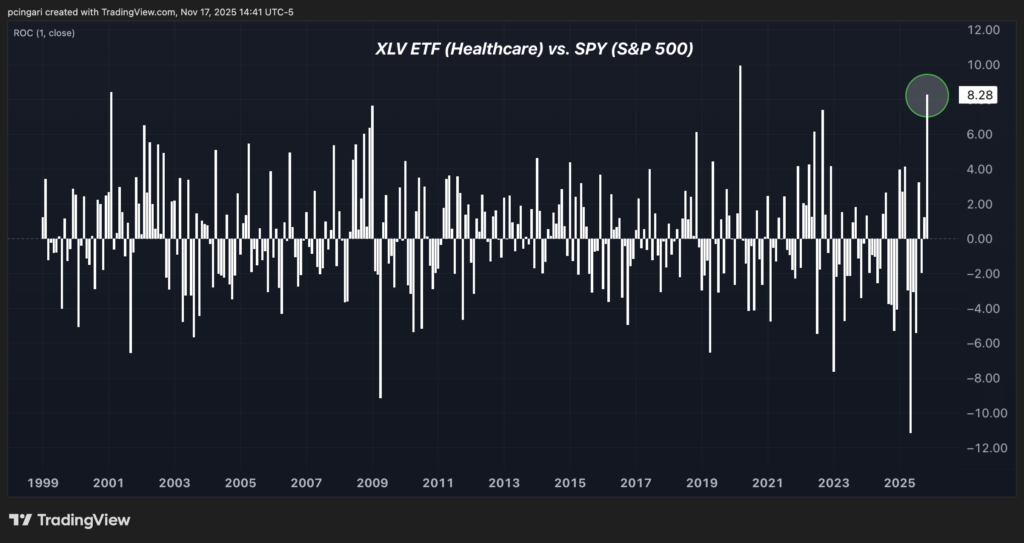
Something big is happening in healthcare, as pharma stocks have recently rallied on breakthrough AI developments that could reshape the entire industry.
The Healthcare Select Sector SPDR Fund (NYSE:XLV) is having its third-best month against the S&P 500 since 1999, and a big part of that momentum has to do with one company: Eli Lilly & Co. (NYSE:LLY).
Lilly's been on fire lately, not just because of its wildly popular weight-loss drug Zepbound, but because it's leaning hard into artificial intelligence.
According to Jordi Visser, head of AI Macro Nexus Research at 22V Research, we may be at the early stages of one of the most profound disruptions in biotech — a shift that could rival what semiconductors did for computing.
Chart: Healthcare Is Having Its Third Best Month Ever Against The Broader Market

The AI Pharma Stack
Earlier this month, Eli Lilly signed a $100 million-plus deal with Insilico Medicine, a company using generative AI to design new drugs entirely on computers.
This came just weeks after Lilly teamed up with Nvidia Corp. (NASDAQ:NVDA) to build what it calls the industry's most powerful AI supercomputer.
The idea: shrink drug development timelines from a decade to just a few years.
"This is the inflection point people need to pay attention to," Visser said in his latest YouTube video.
"AI drug discovery means shrinking cost, shrinking time, and increasing efficacy. That means changing profit margins — and ultimately, lower drug prices."
And while AI hums in the background, a new structure is quietly taking shape across the pharmaceutical world.
Alphabet Inc.‘s (NASDAQ:GOOGL) Isomorphic Labs acts as the brain, using generalizable AI to decode biology.
Insilico Medicine plays the role of the hands, generating novel drug candidates through AI-powered design. And Eli Lilly steps in as the body, running clinical trials, navigating regulation, and bringing the drugs to market.
Together, they're building what could become the "AI Pharma Stack"—a fully integrated, end-to-end system for discovering, testing, and delivering the next generation of medicine.
Traditionally, developing a single drug takes 10–12 years and costs north of $2 billion. But with AI-powered platforms running high-speed simulations and predictive models, that timeline could shrink to just 2–3 years.
Drug development costs could fall by up to 90%, according to Visser's estimates.
AI Is Coming For Cancer
Perhaps the most powerful implication of all this? Turning cancer into a manageable chronic disease.
Many AI-led pharma firms — including Insilico and Isomorphic — are focusing on oncology and immunology as initial targets. These diseases are devastating, expensive, and, importantly, well-modeled.
With enough data, AI tools can simulate how new drug compounds interact with cancer cells and the immune system, all before a single clinical trial is conducted.
And it's working. Isomorphic's models are already predicting protein structures with near-experimental accuracy. That means faster cycles, fewer failed trials, and ultimately, a greater chance of success.
"We are on the cusp of being able to say that cancer becomes a chronic condition," Visser said. "If you think that's not investable, or you think AI is a bubble, you're missing the point."
According to the expert, what semiconductors did for productivity in the digital economy, AI could do for health.
That means a re-rating of companies like Lilly, Novartis AG (NYSE:NVS), or Merck & Co Inc.. (NYSE:MRK) — once considered slow-growth, defensive names, now at the forefront of radical disruption.
"This is what happened to Oracle. This is what happened to IBM. They go from boring companies to AI platforms."
The economics are compelling. Lower R&D costs mean higher margins. Higher margins mean more pricing flexibility — aligning with political pressure to lower drug costs. That's a rare moment of alignment between innovation, regulation, and profitability.
Healthcare spending shifts from high-cost acute care to manageable chronic conditions. Productivity improves. Fiscal pressure eases.
"The trades that came out of Ozempic were massive," Visser said.
"But this is bigger. Much bigger."
Read Next:
Image created using artificial intelligence via Midjourney.







